 |
|
Inside Hanoi
09-Mar: 2015
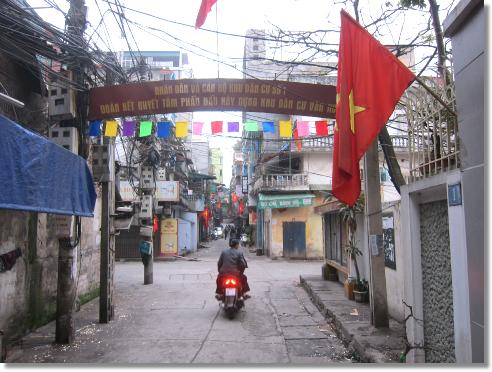
I'm staying in the "old quarter" of Hanoi. The streets are narrow, twisting and behind the main streets, which are not large, are alleys upon alleys. Like Saigon, it is a warren of commerce and residences, some of it visible from the street, some not. Yesterday was the first day of Tet, the new year's celebration and in the morning the streets were empty, the storefronts and houses closed and gated. People had returned to their ancestral homes in the countryside or else were gathering with friends and families behind the closed doors (and sometimes open ones).
The sky has been overcast since I arrived here. The humidity is high and the weather mild, almost cold. It looks cold: grey, damp and the people here dress as it was was snowing, sometimes looking ludicrously bundled in parkas and scarves, even though the temperature is only 64 degrees Fahrenheit. Part of the need to be bundled is there is no interior heating, nor insulation, in these drafty cement buildings. When the interior temperate is in the 50s or low 60s, it is damp and cold.
Yesterday morning there were ashes on the sidewalks and curbs from street fires. Later in the day fresh fires smoldered and flared. Small collections of paper and cardboard were being burned streetside, sending pungent smoke into the air, giving off heat. Being symbolically burned were those things not needed, not wanted, the undesirables of last year: obstructions, depression and illness; ill-fame, bad luck and ancestral curses. All of the things none of us want being burned in the streetside fires.
I took a photograph of a street fire still burning outside of a beauty salon on Bao Linh Street. Nearby was the ubiquitous Vietnamese flag. On a given street you might see dozens of them, flying at angles from flagpoles. A five-pointed yellow star on a bright red background. The red represents revolution and blood (and has been such a symbol since the Paris Commune of 1871), the star the five classes of Vietnamese society: intellectuals, farmers, workers, businessman and the military. The flag looks all the brighter again the background of cement, gloom, dampness and grey skies that is Hanoi in February (Saigon was hot, dry and smoggy). The hagiography of the flag, like all flags belies the nooks and crannies of history that it also represents.
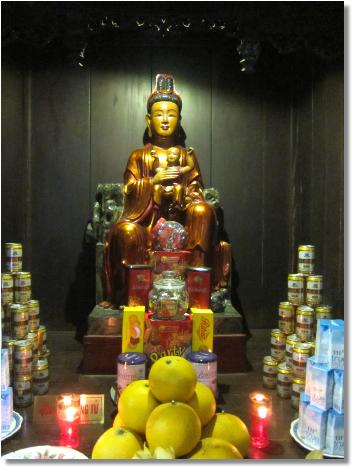
. . .
The street fires are still the most moving thing to come upon, and I pause and nod at each one I encounter. I nod and inhale the smoke, always so fragrant (all the more so in the dampness and gloom). There is a ghost-like quality for me here. It is Tet and many stores and shops are still closed, but there are also more than enough people on the street, so it's not that. Perhaps Hanoi is the ghost to Saigon. Whereas I ultimately found Saigon a place I connected to deeply, a place I loved, a place that became a potent muse, in Hanoi I haven't found that yet. Hanoi is a ghost world, a palimpsest I cannot yet read. It's been a time of sometimes desultory aloneness and so, I was just told, I need to surrender to that. My clairvoyant friend gave me that advice over the phone: there will be a shift, but for now, just rest in not being able to figure anything out. Let that be a retreat you surrender to. I must wait for the ghost to be revealed, for something in the atmosphere to quicken and congeal.
On my first day here I passed an old lady on the street. And as I passed her, she hit me on the arm. Gave me a good whack. I turned around and at first she glared fiercely at me. Not having any idea what I'd done - though I felt I must have committed a street-side faux pas of some kind - I simply stared back at her. She held my gaze for a moment and then broke into a wide smile. And I of course smiled back. I can only imagine what this woman - tiny of frame, thin as a bird, but sinuous and tough - has seen in her life. My encounter with her remains inscrutable, but the two-second journey from being hit to being smiled at is the most penetrating and lingering moment of affection I've experienced in Hanoi.
What about my hotel room? It smells badly of mold (and when I get down to the floor it even smells of death, like a rodent has perished). This hotel got great reviews on the Internet, but up close it is slightly repellent. I've taken the mold as a signature of the time, nothing to recoil from (it hasn't effected my respiratory system). And what about the room number? It is 606, numerologically a 3: "3s are imaginative, expressive communicators and artists." What I would give for some creative inspiration right now! Minuscule ants crawl across the desk and keyboard of my computer (though day after day their population remains few). Outside the window, roosters crow day and night. The streets below are narrow and so well used, covered in grime which is a mixture of engine exhaust, the grease from street-food cooking, dirt, cigarette butts and, this time of year, New Year's eve confetti. Old women on tiny stools sit by the roads. Children play in them. Motorcycles, bicycles, cyclos and automobiles navigate them.
. . .
Last night I discovered the statue of Li Thai To, the 11th Century emperor who moved the capital and first established Hanoi, then called Thang Long, as the imperial seat. Not every place can claim a thousand year history, especially not as the capital of a country. This is part of the palimpsest that is so tangibly here, the layers of history that can be felt though not seen as they can be in Rome, Paris or Istanbul. The layers have been lost just as wooden houses have been lost, replaced by concrete, just as the French Colonial era transformed Hanoi in ways that can be seen, since many colonial buildings remain. And the Soviet era left its influence in stark, dismal and arch functional apartments, some of them now abandoned due to their being so inhospitable.
Li Thai To's statue looms above Indira Gandhi Square, so named because the one-time prime minister governed a non-aligned India, an India more favorably disposed to the Soviet Union, as Vietnam was. Now the only face of communism an incidental traveler seems to encounter is the occasional uniformed soldier, dressed in a uniform of green with red epaulets, looking very vintage communist, and in the ubiquitous flags.
There are amazing treasures here that I have discovered on my walks (and that the guidebooks and on-line literature don't often mention): the shrines, pagodas and temples of Hanoi. Some are large and visible from a distance (such as the two along West Lake), but most are barely visible, down a small alley or next door to a coffee shop. Inside are some of the most refined, ornate, tastefully decorated and opulent interiors I've ever seen, masterpieces of Buddhist and other ancestral lineages, masterpieces of enriching presence. How can I describe them? Pillars and rafters of wood, sanded to a fine, soft and ancient patina. Offerings to the shines (because this is Tet) of everything sweet and intoxicating imaginable, from stacked up cans of Coca Cola and local beer to tins of cookies and plates piled high with fruit. People have left and are still leaving (because Tet goes on for days) 1, 5 and 10 dong notes on the shrines (the latter worth about fifty cents US). They bow deeply to the shrine, three times and then offer the notes. The shrines themselves consist of Buddha figures and patriarchs (and some matriarchs) of the lineage, of Quan Yin and other Bodhisattvas, and of every imaginable wisdom holder. The shrines are precise, immaculate and will it by candles and electric lights.
. . .
A Vietnamese woman named Mai became my part time companion, informal tour guide and de facto guardian angel. We met in one of the temples, a little moment of contact in which we happened to say hello and then kept talking. A spark of attraction between us that we navigated through the little English Mai had and that we could share into five afternoon outings to visit what felt to me like countless shrines of Hanoi. Mai was a 3:00 PM antidote each day to my desultoriness, and for the next few hours we took taxicabs to various pagodas and sometimes got a meal together.
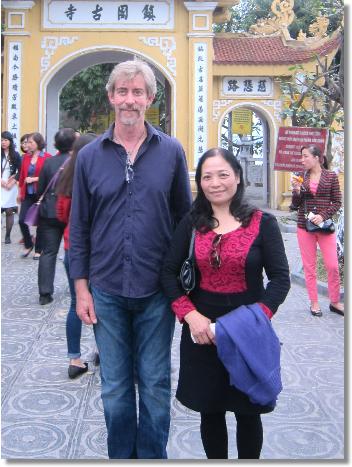
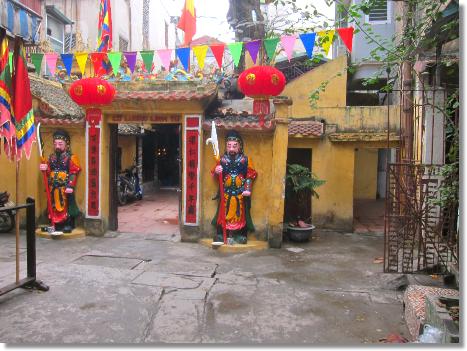
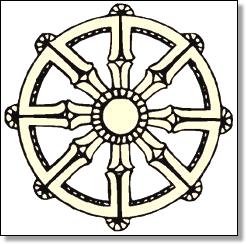
This is one of a series of essays under the overall title, Cambodia 2015. - Bill Scheffel
What Makes Something "Cambodian"?
The Cambodian Market: Wheel of the Quivering Meat Conception
Cambodia Has No Highway Patrol
![]()
